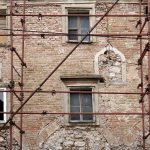If you’ve ever found yourself contemplating a room makeover, you might have wondered whether you can paint over wallpaper. It’s a common question for homeowners seeking a fresh look without the hassle of wallpaper removal. This article explores the ins and outs of painting over wallpaper and provides insights from expert painting services to help you make an informed decision.
When You Should Not Paint Over Wallpaper
Before delving into the process of painting wallpaper, it’s essential to understand when it might not be the best option. While painting over wallpaper can be convenient, it’s unsuitable for all situations. Here are some instances when you should avoid this approach:
1. Severely Damaged Wallpaper
Painting over wallpaper is not advisable if it is in poor condition with peeling edges, bubbles, or extensive damage. The paint won’t effectively conceal these flaws and may even exacerbate the issue by causing the wallpaper to detach further. In such cases, removing the wallpaper and starting with a clean canvas is better.
2. Textured or Embossed Wallpaper
Textured or embossed wallpaper can pose a challenge when painting over it. The texture may still be visible even after applying multiple coats of paint, resulting in an uneven finish. For a smooth and professional-looking result, removing textured wallpaper is often recommended before painting.
3. Wallpaper with a Vinyl Coating
Wallpaper with a vinyl coating, which is commonly found in kitchens and bathrooms, is less receptive to paint. The vinyl layer can repel paint, making it difficult to achieve good adhesion. In such cases, the preferred route is to remove the wallpaper and prepare the wall surface properly. When in doubt, it is best to consult professional painting services to get expert recommendations.
When Painting Over Wallpaper is a Good Option
1. Wallpaper Difficult to Remove
One of the main reasons homeowners opt to paint over wallpaper is when it’s exceptionally challenging to remove. Some older wallpapers may be firmly adhered to the wall, and attempting to remove them could damage the underlying drywall. In such instances, painting over the existing wallpaper can be a practical solution.
2. Quick Room Update
If you want to give your room a fresh look without investing significant time and effort in wallpaper removal, painting over it can be an efficient option. It allows you to achieve a new colour scheme and aesthetic without the labour-intensive process of wallpaper removal and wall preparation.
3. Budget Constraints
Painting over wallpaper is often more budget-friendly than removal and wall surface preparation. It can save you money on labour and materials, making it a cost-effective choice for homeowners on a tight budget.
Expert Painting Services Guide to Paint Over Wallpaper
If you’ve decided that painting over wallpaper is the right choice for your project, follow these steps with guidance from expert painting services:
Things You Need to Paint Over Wallpaper
- Paint: Choose high-quality latex paint in your desired colour.
- Primer: Use a latex-based primer to ensure good paint adhesion.
- Painter’s Tape: This will help protect trim and adjacent surfaces.
- Paint Roller and Tray: For applying paint evenly.
- Paintbrush: Use it for cutting along edges and corners.
- Spackling Compound: To fill any holes or imperfections in the wallpaper.
- Sandpaper: For smoothing out patched areas.
- Clean Cloth: To wipe down the walls.
- Drop Cloths: To protect your flooring and furniture.
Step 1: Clean The Walls
Begin by thoroughly cleaning the wallpapered walls. Remove dust, dirt, or grease using a mild detergent and water solution. Allow the walls to dry completely before proceeding to the next step.
Step 2: Repair Any Damages To The Walls
Inspect the wallpaper for any tears, loose edges, or holes. Use a spackling compound to patch and repair these areas. After the compound dries, sand it down to create a smooth surface.
Step 3: Tape Up
Apply painter’s tape to the edges of trim, ceilings, and any adjacent surfaces you want to protect from paint splatter. This step ensures clean, precise lines and prevents paint from accidentally getting on areas you don’t want it to.
Step 4: Prime The Walls
Priming is crucial when painting over wallpaper. It helps the paint adhere better and minimises the chances of the wallpaper pattern showing through. Apply a coat of latex-based primer to the entire wallpapered surface and allow it to dry according to the manufacturer’s instructions.
Step 5: Start Painting
Once the primer is dry, you can start painting. Use a paint roller for larger areas and a brush for corners and edges. Apply at least two coats of paint, allowing each coat to dry thoroughly before adding the next.
How to Paint Over Textured Or Patterned Wallpaper
The basic process of painting over textured or patterned wallpaper remains the same as painting over standard wallpaper. However, there are a few specific aspects to keep in mind:
1. Priming
As with any wallpaper painting project, proper priming is crucial. Use a high-quality primer designed for wallpaper and ensure it’s evenly applied to create a smooth surface for your paint to adhere to. This step helps prevent the underlying texture or pattern from bleeding through the paint.
2. Painting Technique
When dealing with textured or patterned wallpaper, it’s essential to adopt the right painting technique. Use a roller with a thicker nap to get paint into all the grooves and crevices. Work in small sections to ensure thorough coverage, and use a paintbrush for any areas the roller can’t reach.
3. Excess Paint Accumulation
One common issue when painting over textured wallpaper is the potential for excess paint to accumulate in the grooves and embossed patterns. To avoid this, be mindful of your paint application. Don’t overload the roller or brush. Consider using a blotting technique to remove excess paint before applying it to the wallpaper. It helps to hire professional painting services to ensure the desired results.
The Right Paint and Color for Painting Over Textured Wallpaper
1. Paint Type
Opt for a high-quality latex or acrylic paint. These types of paint are known for their durability and adhesion, which are essential when painting over wallpaper. Avoid using oil-based paints, as they may not adhere as well and can become brittle over time.
2. Color Selection
The choice of colour can significantly impact the final result. Lighter colours tend to do a better job of concealing the wallpaper’s texture or pattern. A neutral or light-coloured paint is your best bet to mask the existing design completely. However, if you embrace the texture or pattern as part of your decor, you can choose a complementary or contrasting colour that highlights the wallpaper’s features.
3. Finish
Your paint’s finish can also make a difference. In general, eggshell or satin finishes are ideal for walls, as they strike a balance between durability and ease of cleaning. However, if you want to downplay the texture of the wallpaper, a matte finish can help soften its appearance. You can also consider consulting an expert painting service to get recommendations.
Why Consider Professional Painting Services to Handle Such Tasks
Painting over textured or patterned wallpaper is not just about following the proper steps but also about ensuring a flawless result. Here are some compelling reasons why you should consider only professional painting services for this specialised task:
- Expertise: Professional house painters in Hobart have the knowledge and experience to assess the condition of your wallpaper and determine whether it’s suitable for painting over. They can identify any potential issues and address them before starting the project.
- Proper Preparation: Preparation is critical to a successful wallpaper painting project. Professionals know how to properly clean, prime, and apply paint to textured or patterned wallpaper, ensuring an even finish and long-lasting results.
- Specialised Tools and Materials: Professional painters have access to high-quality tools and materials specifically designed for wallpaper painting. This includes the right primers, paints, and application equipment to achieve the best outcome.
- Attention to Detail: Achieving a smooth and uniform finish when painting over textured or patterned wallpaper requires experience and attention to detail. Painters have the skills to ensure that every nook and cranny is properly covered, leaving a flawless result.
- Time and Convenience: Painting projects can be time-consuming, especially when dealing with challenging wallpaper. Hiring painting services allows you to save time and avoid the hassle of DIY efforts so you can enjoy your newly painted space sooner.
- Long-Term Value: When you invest in professional services, you’re not just enhancing the aesthetics of your home. You’re also adding long-term value. A well-executed paint job can increase your property’s appeal and resale value.
Common Questions Answered By House Painters in Hobart
1. Can you remove the wallpaper with fabric softener?
Yes, fabric softener can be used as a DIY wallpaper removal solution. Mix a solution of one part fabric softener to three parts water and apply it to the wallpaper using a sponge or spray bottle. Allow it to soak for a few minutes, then gently scrape off the wallpaper with a scraper. This method can help soften the wallpaper adhesive, making removing it easier.
2. Can vinegar remove wallpaper?
Vinegar can be an effective wallpaper removal solution. Mix equal parts vinegar and water and apply the solution to the wallpaper. Allow it to sit for a few minutes to soften the adhesive, then carefully peel off the wallpaper using a wallpaper scraper or putty knife. Vinegar’s acidity can help loosen the wallpaper glue.
3. Can you remove wallpaper without impacting the wall?
Removing wallpaper without damaging the wall is possible with the right tools and techniques. Follow these steps to minimise wall damage during wallpaper removal:
- Score the wallpaper: Use a wallpaper scorer or a utility knife to create small perforations in the wallpaper. This allows moisture to penetrate and soften the adhesive.
- Apply a wallpaper remover solution: Mix warm water with a wallpaper remover concentrate or a few drops of dish soap. Apply the solution to the wallpaper using a sponge or spray bottle. Let it sit for about 15 minutes to loosen the adhesive.
- Scrape off the wallpaper: Gently scrape off the wallpaper with a wallpaper scraper or putty knife, starting from a corner or edge. Work carefully to avoid gouging or damaging the wall. If the wallpaper is particularly stubborn, reapply the wallpaper remover solution as needed.
- Clean the wall: Once the wallpaper is removed, thoroughly remove any remaining adhesive. Rinse with water and allow it to dry.
- Repair any damage: If any minor damage or imperfections occur during removal, patch them with a spackling compound and sand them smoothly before painting or applying new wallpaper.
Everything said, if this is your first painting attempt, it is best to hire painting services to avoid any hassles or potential damage.
We Offer the Best Wallpaper Painting Services in Hobart
Unleash the full potential of your living space with the finest wallpaper painting services in Hobart. At Dyson Painters, we’re dedicated to turning your decorating dreams into a stunning reality. Tired of that outdated wallpaper? Our skilled team is here to breathe new life into your interiors, making them more vibrant and stylish.
We take pride in our top-tier craftsmanship, attention to detail, and commitment to customer satisfaction. Your home deserves nothing but the best, and that’s precisely what we have been delivering to houses for over half a century.
Take the first step towards your home transformation. Contact us at 0420-213-214 or email us at admin@dysonpainters.com.au to schedule a consultation. Let’s discuss your vision, explore design possibilities, and create a personalised plan tailored to your needs and preferences.
Also Read:
Wallpaper Painting Vs Painting: Which is Better?





